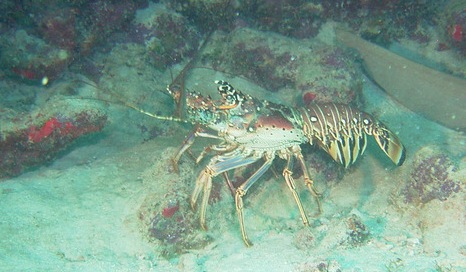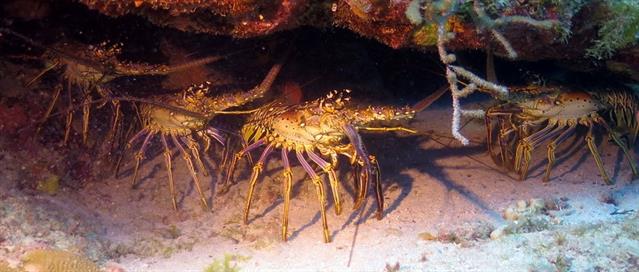



Panulirus argus
Size
Length up to 60cm (24")
Description:
Adult: Tan, black and white with large white spots on abdomen. Two black and white horns between eyes. The first pair of antennae are slender, black or dark brown and biramous. The second pair of antennae are longer than the body, and covered with forward pointing spines. The bases of the second antennae are thick, can have a bluish tinge, and are likewise covered with rows of spines. The legs are usually striped longitudinally with blue and yellow and terminate in a single spine-like point. The somites of the abdomen are smooth and have a shallow furrow across the middle. Each has pairs of swimmerets on the underside that are yellow and black. The lobes of the tail are colored similarly to the swimmerets.
Juvenile: Banded legs with a broad stripe on back.
Ecology
Nocturnal, feeding on molluscs, detritus, vegetable material and dead animals. Occurs at depths down to 90 m, perhaps even deeper; usually inhabits shallow waters and found among rocks, on reefs, eelgrass beds or in any habitat that provides protection. The species is gregarious and migratory. Estimates for size at 50% maturity range from 81 mm to 92 mm (Carapace Length).
Life Cycle
They typically moult 2 - 3 times a year. Females move to deeper water for spawning and there are mass migrations, when the animals, in single files of up to 50 individuals, move in a certain direction in daytime, each animal having body contact with the next through the antennae. Fertilisation via indirect sperm transferHatches from eggs carried externally by the female for around four weeks.They begin life as a free-swimming, microscopic phyllosoma larvae. After about one year, the larvae settle in algae, in Thalassia testudinum seagrass beds, or among mangrove roots. After undergoing several molts, they migrate to the coral reefs.
Length up to 60cm (24")
Description:
Adult: Tan, black and white with large white spots on abdomen. Two black and white horns between eyes. The first pair of antennae are slender, black or dark brown and biramous. The second pair of antennae are longer than the body, and covered with forward pointing spines. The bases of the second antennae are thick, can have a bluish tinge, and are likewise covered with rows of spines. The legs are usually striped longitudinally with blue and yellow and terminate in a single spine-like point. The somites of the abdomen are smooth and have a shallow furrow across the middle. Each has pairs of swimmerets on the underside that are yellow and black. The lobes of the tail are colored similarly to the swimmerets.
Juvenile: Banded legs with a broad stripe on back.
Ecology
Nocturnal, feeding on molluscs, detritus, vegetable material and dead animals. Occurs at depths down to 90 m, perhaps even deeper; usually inhabits shallow waters and found among rocks, on reefs, eelgrass beds or in any habitat that provides protection. The species is gregarious and migratory. Estimates for size at 50% maturity range from 81 mm to 92 mm (Carapace Length).
Life Cycle
They typically moult 2 - 3 times a year. Females move to deeper water for spawning and there are mass migrations, when the animals, in single files of up to 50 individuals, move in a certain direction in daytime, each animal having body contact with the next through the antennae. Fertilisation via indirect sperm transferHatches from eggs carried externally by the female for around four weeks.They begin life as a free-swimming, microscopic phyllosoma larvae. After about one year, the larvae settle in algae, in Thalassia testudinum seagrass beds, or among mangrove roots. After undergoing several molts, they migrate to the coral reefs.

| Ecological Descriptors | ||||
| Habitat | Size (cm) | Diet | Behaviour | Sex |
| Co, R, S | 60 | Mol, Sca, Det, Veg Noct | I | F |


218
219






233


617

